In July 1674, building work was being carried out at
the Tower of London, making the White Tower ready to receive papers from the
Six Clerks’ Office, and when creating a staircase into the chapel, bones, which
had the proportions of the two little Princes, were found beneath an old
staircase.
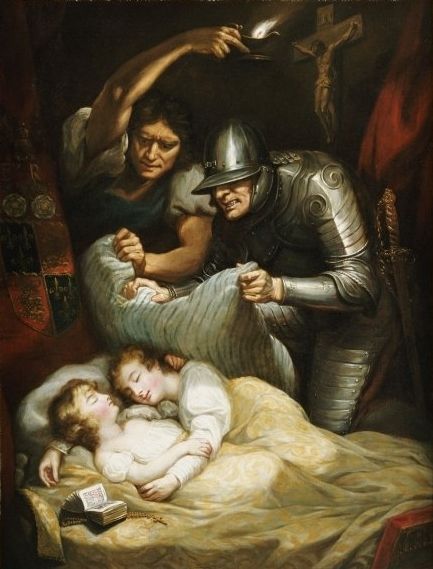 |
| Murdering the Princes in the Tower |
King Charles II had them moved to Henry VII’s Lady Chapel,
Westminster Abbey, where they were placed in an urn with a Latin inscription on
marble telling how their remains had been discovered one hundred and ninety-one
years after their secret suffocation and ignominious burial at the orders of
the perfidious Richard III.
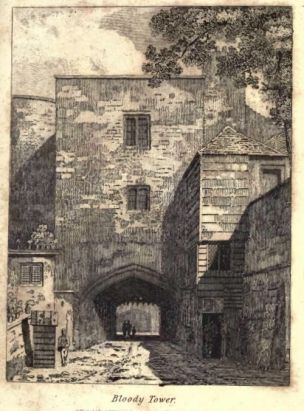 |
| The Bloody Tower |
Now, another tower within the Tower of London,
formerly called the Garden Tower during the reign of Henry VIII, was by the
reign of his daughter Elizabeth being popularly called the Bloody Tower, as it
was here that the Princes were supposedly murdered, but quite how suffocation
can be described as bloody is another matter. But I’ll come back to that later.
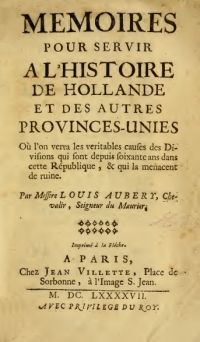 |
| Louis Aubrey du Maurier - Memoirs pour servir a l'Historie de Hollande - 1680 - 1697 ed. |
In 1680, Memoirs pour servir a l’Histoire de Hollande by Louis Aubrey du
Maurier was published in Paris, in which there is an account of a secret
chamber discovered during the time of Elizabeth I, as part of a search for
extra space in which to house prisoners.
“They found in this Chamber, upon a bed, two small bodies, together with two neck collars. These were the skeletons of King Edward V and the Duke of York, his brother, whom their Uncle Richard the Cruel had strangled to get the Crown to himself, which Henry VII, Grandfather to Queen Elizabeth, deprived him of, together with his life.”
 |
| Louis Aubrey du Maurier - account of the discovery of the skeletons - Memoirs pour servir a l'Historie de Hollande - 1680 - 1697 ed. |
The account then relates how Elizabeth, not wishing to have memories of the
crime revived, ordered the chamber shut up again, only for a later King
(presumably Charles II) to have it reopened and the bones transferred to the
Abbey. The first English translation, by Thomas Brown in 1693, omits this story
altogether, but another work, The History of the Life and Reigne of King
Richard the Third, by George Buck, of 1647, has a similar story about
“… certaine bones like to the bones of a Child being found lately in a high defolate Turret, fuppofed to be the bones of one of thefe Princes - others are of opinion it was the carcaffe of an Ape kept in the Tower, that in his old age had happened into that place to die in.”
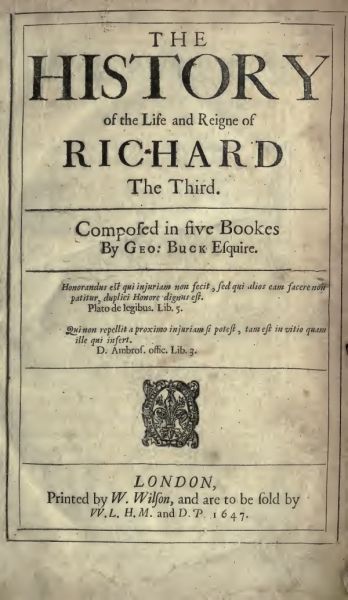 |
| George Buck - The History of the Life and Reigne of Richard the Third - 1647 |
There had long been a menagerie in
the Tower (Henry III had a polar bear kept there from 1252), so it is possible
that an escaped ape could have climbed into a tower, become trapped and died
there, but surely even in Elizabethan times someone, somewhere, could have made
a positive identification. I’ve mentioned Sir Thomas More’s History of King
Richard III yesterday, and his (biased and unreliable) text tells us that after
the Princes had been killed, James Tyrrell
“… caused those murtherers to burye them at the stayre foote, metely depe in the grounde vnder a great heape of stones.”
But that wasn’t the end of, as Robert Brakenbury, lieutenant of
the Tower, felt that ‘so vile a corner’ was not a fit place for what
was, after all, the body of a King of England, and on his orders, an unnamed
priest,
“… toke vp the bodyes again, and secretelye entered them in such place, as by the occasion of his deathe, whiche onely knew it, could neuer synce come to light.”
Which is just a wee bit convenient, if anyone came
asking any awkward questions. So, More’s initial story conforms to the finding
the bones beneath a staircase in the White Tower, but the second part, when the
bodies were moved, contradicts this, which leaves us no nearer.
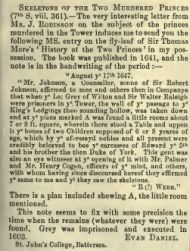 |
| E Daniel - Notes and Queries - 1889 |
In a letter to Notes
and Queries (Series 7, Vol VIII, December 21st 1889) Evan Daniel
writes that he has a copy of More’s book, and in a manuscript note on the
fly-leaf, dated August 7th 1647, a Jo. Webb has written,
“… when ye Lo: Grey of Wilton and Sir Walter Raleigh were prisoners in ye Tower, the wall of ye passage to ye King's Lodgings then sounding hollow, was taken down and at ye place marked A was found a little roome about 7 or 8 ft square, wherein there stood a Table and uppon it ye bones of two children supposed of 6 or 8 yeares of age, which by ye aforesaid nobles and all present were credibly believed to bee ye carcasses of Edward ye 5th and his brother the then Duke of York. This gent was also an eye witnesse at ye opening of it with Mr. Palmer and Mr. Henry Cogan, officers of ye mint, and others, with whom having since discoursed hereof they affirmed ye same to me and yt they saw the skeletons.”
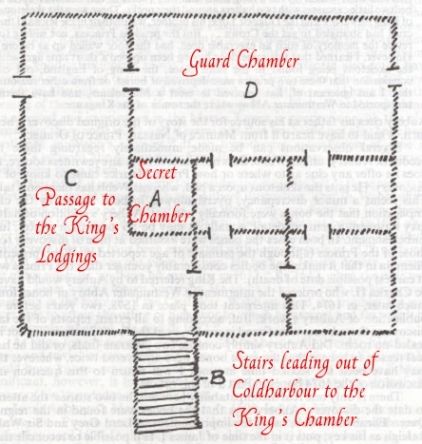 |
| Diagram relating to Webb's note |
The place marked A can be seen on this diagram; the present whereabouts of
Daniel’s copy of this book are unknown. Jo. Webb was John Webb, the assistant
to Inigo Jones, Surveyor of the King’s Works, although when this note was
written, Jones and Webb had lost their positions during upheavals of the Civil
War.
Then, when later writers become involved, the possibilities get totally
out of hand - the Princes died of natural causes (so why bother hiding the
bodies?), one of them fell off a bridge in the Tower and died, they were
spirited away by persons unknown and lodged safely in Europe, one had his
throat cut and the other was smothered and their bodies were thrown overboard
from a ship bound for Flanders, and so on and so forth, and the waters become
decidedly muddier.
No comments:
Post a Comment